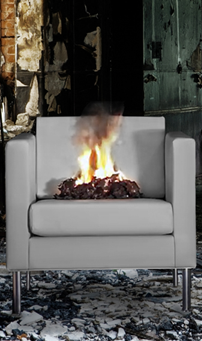
Fire protection in offices
In contrast to building products, there is currently no closed set of regulations for the fire protection requirements for furniture. Therefore, attempts are often made to transfer requirements and tests for building products to furniture, for example the test class B1, which is widely known in Germany. However, this is not very effective. In fact, there are recommendations of the fire brigades and specifications in the area of workplace law (Arbeitsstättenrechts) that can be used instead.
Protection goals and basic requirements

In case of danger, persons present should be able to leave the premises independently. This also applies to guests without detailed local knowledge. At the same time, the fire brigade must be able to get to the source of the fire as quickly as possible. The basic prerequisite for this are escape and rescue routes of sufficient width that lead as quickly as possible to the outside. Good signage is also required.
In Germany, details are given in the state building regulations and the Technical Rules for the Workplace Ordinance (ArbStättV), in particular ASR A2.2 (measures against fires), ASR A2.3 (escape routes and emergency exits) and ASR V3a.2 (barrier-free design of workplaces). There may also be additional requirements. What these are must be clarified with the locally responsible approval authorities, usually the fire protection service at professional fire brigades or district offices/county administrative authorities.
Requirements for furniture

What requirements should be placed on the fire behaviour of furniture depends on where it is placed.
According to building regulations, no special requirements are imposed on furniture in recreation rooms up to a maximum of 1,600 m2 . In this context, recreation rooms are those rooms "which are intended or suitable for the not only temporary stay of people". Offices, meeting rooms, workshop rooms, etc. are therefore recreation rooms within the meaning of the Building Code.
The situation is different in the area of escape and rescue routes outside these common rooms. In order to enable an unhindered exit from the premises in case of danger, escape and rescue routes must be free of objects that could impede escape. The placement of furniture or other furnishings in the area of escape and rescue routes must therefore be avoided as a matter of principle.
Surface temperature
Especially in open office landscapes, it is often impossible to do without placing furniture in the area of escape and rescue routes. This is especially true for seating furniture. Often, in deviation from the basic rule (see above), toleration is possible. Tolerance must be clarified on a case-by-case basis with the responsible building supervisory authorities or the bodies they have appointed, as well as with the occupational safety officers.
Recommendations on which furniture can be tolerated where are provided by the German Working Group for Preventive Fire and Hazard Protection (AGBF) (Vorbeugender Brand- und Gefahrenschutz, Empfehlungen zur Risikoeinschätzung von Brandlasten in Rettungswegen). These state that:
a) only non-combustible, permanently mounted furniture should be used in necessary stairwells;
b) in necessary corridors, (seating) furniture may be used in individual arrangements, provided that frames are flame-retardant and a certificate of class P-a according to DIN 66084 is available for upholstery.
Air quality
Widths of escape routes shall not be reduced by placing furniture or other objects on them. Specifications for the widths of escape and rescue routes are defined in ASR A2.3 (see the remarks on traffic routes). In addition, the specifications in the building regulations of the federal states as well as the instructions of the lower building supervisory authorities must be taken into account, if available.
Testing of upholstered furniture

Bild: SMV
In its recommendations for seating furniture placed in the area of escape and rescue routes, the AGBF refers to class P-a according to DIN 66084. What does this mean?
DIN 66084 (classification of the burning behaviour of upholstered composites) is a German standard. It defines three test classes:
- Class P-a is based on a test with a paper pad. This is placed against the rear edge of the seat cushion and ignited. The spread of the flame and the time it takes for the flames to extinguish are assessed. The test was designed for upholstered composites, but it can also be used to test non-upholstered seating furniture.
- Class P-b is based on the European standard DIN EN 1021-2. A gas flame simulating a burning match is used as the fire source. The test is also known as the match test. This test was also designed for upholstery composites.
- Class P-c uses cigarettes as the ignition source.
IBA Fire Protection Guide
Details have been compiled in a guideline by the expert committees of the IBA in cooperation with DIN and with the support of experts from the fire brigades. The guideline entitled "Fire protection recommendations for the use of seating furniture in offices and educational institutions in Germany - requirements and tests" contains three main parts. Part 1 describes the protection goals, refers to relevant regulations and defines relevant terms. Part 2 specifies the requirements for seating furniture and Part 3 provides information on testing. Annex A explains the application on the basis of typical office layouts. Appendix D names suitable test centres. The contents of the guide are based on existing regulations and recommendations.
The IBA Fire Protection Guide (IBA Brandschutzleitfaden) was published by Beuth-Verlag in May 2022 and can be ordered there at a price of 24.80 € incl. VAT. [Only available in german]


